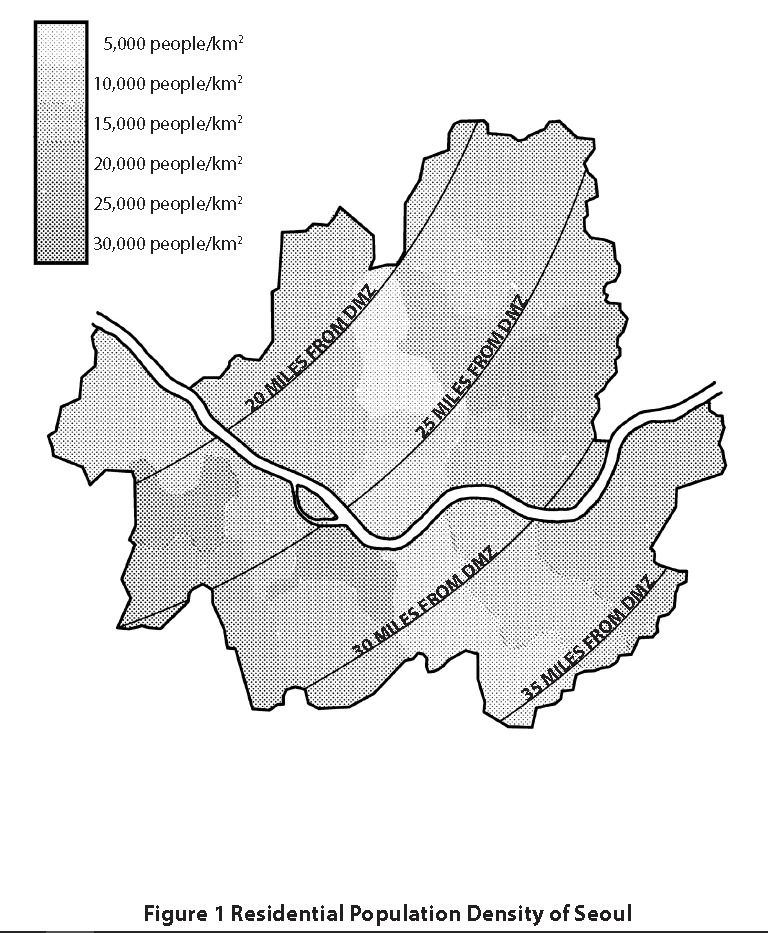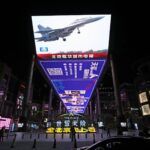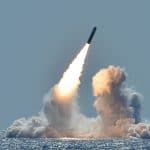Sea of sarin: North Korea’s chemical deterrent
By Reid Kirby | June 21, 2017

North Korea periodically comes into the news as it advances its nuclear and ballistic missile ambitions and continues to employ rhetoric about destroying its enemies. With the Korean Peninsula technically still at war, a growing concern today is that at some point North Korea will acquire the capability to launch a nuclear-armed ballistic missile against the United States or one of its allies. Counterproliferation efforts on the peninsula have had a frustrating history, leading the United States to deploy its Terminal High Altitude Area Defense (THAAD) missile system in South Korea. The US secretary of state, Rex Tillerson, has even suggested the possibility of preemptive military action against the North.
To many analysts of South Korean security, the problem with the preemptive military option is Seoul’s proximity to North Korean artillery placed across the demilitarized zone. North Korea, as a form of strategic deterrence, has periodically threatened to use this artillery to turn Seoul into a “sea of fire.” Lending credence to Pyongyang’s threats are figures from the Global Security website:
“According to one report, a South Korean security analyst suggested that DPRK artillery pieces of calibers 170mm and 240mm ‘could fire 10,000 rounds per minute to Seoul and its environs.’ North Korea has about 500 long-range artillery tubes within range of Seoul, and the total rate of fire of these artillery pieces would be between 2,000 and 4,000 rounds per minute. The DPRK’s [200] 240mm [multiple rocket launchers] fire either 12 or 22 rounds, providing a maximum single salvo of no more than 4,400 rounds.”
Seoul, South Korea’s capital, is the country’s largest and densest population center, with more than 10 million people living in an area of about 600 square kilometers. It is the heart of the world’s fourth-largest metropolitan area and it contains one-fifth of South Korea’s population. It has been estimated that a sustained North Korean artillery attack on Seoul would result in tens of thousands of fatalities if the artillery were armed with conventional high explosives, and in the hundreds of thousands in the case of chemical weapons.
Still, as appalling as these figures appear, they are ultimately figurative, based on vague North Korean threats. It is debatable how many of North Korea’s artillery pieces might be tasked with an attack on Seoul, and if they are within range. Artillery in the demilitarized zone, notes Roger Cavazos of the Nautilus Institute, mostly covers the less densely populated one-third of the city, closer to the DMZ. Using imagery from Google Earth to analyze losses in Seoul due to an artillery attack with high explosives over several days, Cavazos estimates casualties an order of magnitude lower than some others have estimated. While estimates have varied regarding how many artillery pieces the North has, with some estimates running into the thousands, the 700 artillery pieces noted by Global Security is a conservative figure that most analysts have accepted.
Without knowing the details of Pyongyang’s military plans, estimates of the consequences of a North Korean artillery assault are ultimately hypothetical analogies. Where chemical artillery in particular is concerned—because the composition of weapons, payloads, and targets is unknown—the most appropriate analysis of the magnitude of a countervalue threat relies on a heuristic approach. That is, one associates a quantity of sarin with casualty rates based on a generalized application of how chemical weapons operate, rather than performing a simulation of how individual weapons would impact specific targets. Using such an approach, differences in population densities (for example, an attack on Incheon instead of on Seoul) will lower casualty estimates, but will not change the percentage of the targeted population that suffers casualties.
Proponents of preemptive military action against North Korea’s nuclear program, along the lines of Israel’s 1981 Operation Opera against Iraq’s nuclear program, typically ignore North Korea’s history of asymmetrical responses. But North Korea’s capacity to inflict mass chemical casualties on the Seoul area in a “sea of sarin” attack rivals its capacity for nuclear destruction. And compared to the nuclear threat, which involves a finite number of warheads and delivery systems vulnerable to air defenses and antimissile systems, the chemical threat is not as easily negated. Until North Korea becomes a party to the Chemical Weapons Convention, the chemical threat will persist as a potential deterrent to military action against Pyongyang.
Assessing the chemical artillery. North Korea is believed to have placed a high priority on chemical weapons ever since Kim Il-sung’s “Declaration of Chemicalization” in 1961. But the quantity, quality, and durability of the North Korean chemical arsenal are unknown. In the 1970s, intelligence estimates by the United States and South Korea rated North Korea’s chemical warfare potential as mostly defensive. By the late 1980s, views had changed; Pyongyang was believed to have 250 tons of mustard gas and some nerve agents. By 2010, North Korea was estimated to possess 2,500 to 5,000 tons of chemical weapons, mostly sarin and the nerve agent VX. Furthermore, it is assumed that North Korean military doctrine treats chemical weapons as a natural aspect of the nation’s scheme of maneuver, and that chemical weapons would be used from the outset of hostilities. Chemical weapons are reportedly pre-deployed—with one out of three North Korean projectiles believed to be chemical. The February assassination of Kim Jong-nam in Malaysia with VX was undoubtedly a reminder to North Korea’s enemies of the chemical threat that Pyongyang poses.
Bruce Bennett of the RAND Corporation reports that eight manufacturing facilities have been identified in North Korea, capable of producing 5,000 tons of chemical weapons a year during peacetime and 12,000 tons during wartime. The Nuclear Threat Initiative, meanwhile, reports that North Korea has 11 production and storage facilities—in addition to 13 research and development facilities, two test ranges, and four military bases equipped with chemical weapons, as well as facilities near the cities of Kanggye and Sakchu prepared to fill chemical artillery.
Earlier, I cited a claim that North Korea’s 170mm and 240mm artillery could fire 10,000 rounds per minute on Seoul. This claim requires validation. While numbers vary, let’s assume that North Korea has 500 170mm guns and 200 240mm guns (the M-1985)—the conservative numbers specified on the Global Security website—and delve into a bit more detail.
North Korea has the M-1978 Koksan self-propelled gun; the M-1989 variant of this gun carries 12 rounds. Its estimated range is about 25 miles—and with rocket-assisted projectiles, the range can be extended up to about 37 miles. From North Korea’s firing positions along the Kaesong salient of the demilitarized zone, these 170mm guns can cover a one-third to one-half of Seoul without rocket-assisted projectiles and all of Seoul with them (see Figure 1). North Korea’s 240mm artillery rockets are fired from either the 12-rocket M-1985 or the 22-rocket M-1991 mobile multiple rocket launcher. With their range of about 20 miles, these launchers can cover less than one-third of Seoul from the same firing positions along the Kaesong salient. The Juche 100 variant of the 240mm rocket is reported to have a range of about 37 miles.
So the rate of fire of 10,000 rounds per minute appears incorrect—it is apparently based on the rate of fire produced by 155mm artillery pieces (that is, 12 rounds every 3 minutes). The larger-caliber 8-inch gun in the United States has a sustained rate of fire of 10 rounds every 15 minutes, implying that a more appropriate rate for 170mm guns may be 12 rounds per 15 minutes. The firing rate of 240mm rockets is one rocket every 4 seconds, with 5 to 8 minutes to reload after expending either 12 or 22 rockets. Assuming 500 170mm guns and 200 240mm guns, the more likely overall rate of fire is 10,800 rounds every 15 minutes.
With that established, we can calculate how much sarin Seoul might receive during a chemical artillery barrage. The sarin payload of each 240mm rocket is known to be 8 kilograms per rocket, based on the Soviet Katyusha. There is little information available on the 170mm projectile, but a chemical payload of 5 kilograms per projectile can be assumed, based on a US chemical shell of comparable size (the experimental 175mm T223, created for the T145 and T256 guns). Misfires and duds for these artillery weapons would reduce the amount of sarin released on Seoul. Overall, the chemical loading would be about 100 kilograms per square kilometer every 15 minutes.
Civilian losses. How much total sarin North Korea placed on Seoul would depend in part on Pyongyang’s chemical objectives—that is, the casualty rate it hoped to achieve—and on prevailing weather conditions. Anglo-American chemical retaliatory plans during World War II called for a 25 percent casualty rate in urban targets; this objective was retained in the earlier half of the Cold War. Figures from that era for estimating casualties from sarin assumed a median lethal dosage (LCt50) of 70 mg∙min/m3 and a median incapacitating dosage (ICt50) of 35 mg∙min/m3 (for example, if a soldier were breathing 7 milligrams of sarin per cubic meter of air for 10 minutes, there would be a 50 percent probability he would die). The prevailing weather conditions assumed in this analysis are for urban terrain under neutral atmospheric stability, with five-knot winds.
A heuristic approach to estimating the total quantity of sarin required to inflict 25 percent casualties on a city such as Seoul under the specified conditions simplifies the problem into a box model of 600 square kilometers, with casualty rates integrated by area to find the necessary quantity. Using this approach, a “sea of sarin” attack on Seoul would require about 400 kilograms of sarin per square kilometer. Such an attack would require a total of 240 tons of sarin, easily within the estimated size of North Korea’s chemical arsenal. It would take one hour for North Korean artillery to mass sufficient sarin on Seoul to attain a 25 percent casualty objective—or three hours if mixed with high-explosive fire at a 1:2 ratio of chemical to high-explosive projectiles or rockets.
Should North Korea subject Seoul to a 240-ton chemical artillery attack, using the casualty estimating rules in the US Army 1966 field manual FM 3-10 Employment of Chemical Agents, the expected outcome would be as follows:
|
Consequences of a 240-ton sarin attack on Seoul (higher lethal dosage assumed) |
||
|
Effect |
Percentage of population affected |
Number of people affected |
|
Fatalities |
6.5 |
650,000 |
|
Casualties |
19.5 |
1,950,000 |
|
Fringe |
10 to 15 |
1,000,000 to 1,500,000 |
Based on Cold War–era dosage figures for sarin, North Korea could, in a matter of hours, inflict around 25 percent casualties by distributing 240 tons of sarin throughout Seoul. But these dosage figures were indexed for soldiers considered among the healthiest third of a population that is relatively young overall (military service age). For a diverse population encompassing all ages and genders, and with a wide range of health statuses, the lethal and incapacitating dosages of sarin are significantly lower. The Institute for Defense Analysis held a workshop in 1998 to assess the state of the art and to arrive at dosage figures appropriate for the general population. The institute estimated that, for the general population, the median lethal dosage would be only half the dosage assumed in the US Army field manual mentioned above.
The Tokyo subway sarin attack and the Ghouta attack in Syria lend support for using lower dosage figures for a general civilian population. The 1995 attack on the Tokyo subway suggests that the general population will perceive even fringe effects—miosis, for example (excessive constriction of the pupils)—as casualty effects. Furthermore, based on the number of chemical rockets involved, the sarin chemical attack on Ghouta in 2013 resulted in a high number of fatalities. This supports the validity of the lower dosage figures recommended by the institute. If the institute’s figures for a sarin attack on a civilian population are used, the consequences of a North Korean chemical artillery attack become much more severe:
|
Consequences of a 240-ton sarin attack on Seoul (lower lethal dosage assumed) |
||
|
Effects |
Percentage of population affected |
Number of people affected |
|
Fatalities |
25 |
2,500,000 |
|
Severe Casualties |
10 |
1,000,000 |
|
Moderate Casualties |
19 |
1,900,000 |
|
Mild Casualties |
40 |
4,000,000 |
The overall expected casualty rate is nearly total. Compared to the military-dosage scenario, there would be more than 3.8 times the number of fatalities and almost 1.5 times as many moderate-to-severe casualties. Estimates of chemical-weapon effects based on Cold War–era dosage figures are a gross understatement of the number of fatalities and casualties that could be expected in a general civilian population. And if Pyongyang expended quantities of chemical weapons appropriate for a military rather than a civilian population—which is logistically feasible even for a large-area target such as Seoul—the probable effect on a general civilian population would be significant overkill.
How does one visualize such an attack? In more than half of Seoul, the consequences would be comparable to the worst images from the Ghouta sarin attack; in the remainder of the city, consequences would be similar to the Tokyo subway attack. Long-term consequences might not be immediately appreciated, but would be severe as well. For survivors experiencing cardiopulmonary arrest, a fair number might enter a persistent vegetative state due to anoxia. Neuropathy and ataxia (loss of control over bodily movements) might be present for up to three months after the attack in 10 percent of survivors, and about 8 percent would likely have post-traumatic stress disorder for up to five years afterward. Policy makers also should not discount public perceptions of latent effects, whether real or imagined. Gulf War Syndrome, the 1984 Bhopal Disaster, and the use of Agent Orange in Vietnam all provide cautionary examples of the way lingering doubts, with political importance, can persist for more than a decade after a mass chemical incident.
South Korea’s response. To be sure, South Korea is not defenseless against a sea-of-fire countervalue attack. While it is not logistically or technically feasible for South Korea to directly shoot down 10,800 chemical projectiles and rockets every 15 minutes, Seoul has a formidable counter-battery capability to destroy North Korean artillery pieces. The problem would be responding quickly enough—and prioritizing the destruction of 500 170mm guns, and 200 240mm multiple rocket launchers, in a demilitarized zone crowded with numerous other artillery pieces.
The qualitative difference between a nuclear and a chemical deterrent lies in the latter’s mass effect. For example, if three attack aircraft flew on a mission to deliver a nuclear weapon and only one aircraft carried the weapon, a one-in-three probability of losing an aircraft would result in a binary situation: a two-thirds probability that the weapon would have 100 percent of its intended effect or a one-third probability that it would have none of its intended effect. Chemical weapons are different; a one-in-three chance of losing an attack aircraft would mean that two-thirds of the chemical payload would be delivered to the target and mass casualties would still result.
Successful counter-battery attrition against a “sea of sarin” attack would require destroying all North Korean chemical artillery in less than 15 minutes. In general terms, the attrition would shrink the portion of Seoul experiencing a Syrian-type casualty scenario, replacing it with a Tokyo-type casualty picture. A chemical load of 100 kilograms per square kilometer would still result in mild casualties for about 93 percent of the affected population, moderate casualties for about 7 percent, and numerous fatalities in the vicinity of each burst. It is this mass effect from artillery which makes the potential of a North Korean chemical countervalue attack a potent possible deterrent. The mass-action nature of a chemical attack would inflict massive numbers of casualties even in the unlikely scenario that South Korea silenced all North Korean artillery within 15 minutes.
Civil defense could help reduce casualties. Seoul has 3,321 civil defense evacuation centers. Spread across the country are 17,501 protective shelters. There is even a smartphone app to help direct people to the nearest shelter during an attack. After the 2010 North Korean bombardment of Yeonpyeong Island, South Korean civil defense authorities issued 1,300 protective masks to island residents and made plans to boost the chemical protection capabilities of its civil defense corps, including the renovation of public shelters against chemical weapons. Depending on availability, on how much warning is provided, and on public response time, civil defense measures could substantially reduce chemical casualties. If the typical response time were on the order of two minutes into the attack—unlikely—expected casualties would be only one-quarter of those expected in a population without chemical protections.
Reason to hesitate. Details about North Korea’s chemical arsenal are not known with confidence. We do not know for sure what chemical weapons North Korea would use or how it would use them. The North’s repeated threats to turn Seoul into a sea of fire may be only rhetoric. The North’s strategic views concerning deterrence and escalation are also unknown. History shows a willingness in Pyongyang to engage in military provocations short of the level that would justify a renewal of the Korean War. Nonetheless, it is possible to make a rough estimate of the impact of a massive chemical artillery attack on a large urban center such as Seoul. Ultimately, such an estimate is illustrative, representing one of many possible scenarios, yet it can still provide a reasonable understanding of the potential magnitude of a sarin artillery attack against civilian population centers.
If publicly stated intelligence estimates are to be believed, North Korea’s chemical arsenal represents a credible and present threat. How North Korea could apply this threat as a deterrent is speculative. But the destructive potential of the threat should give reasonable cause to hesitate regarding preemptive military options against North Korea’s nuclear weapons ambitions.
Together, we make the world safer.
The Bulletin elevates expert voices above the noise. But as an independent nonprofit organization, our operations depend on the support of readers like you. Help us continue to deliver quality journalism that holds leaders accountable. Your support of our work at any level is important. In return, we promise our coverage will be understandable, influential, vigilant, solution-oriented, and fair-minded. Together we can make a difference.
Topics: Analysis, Technology and Security














